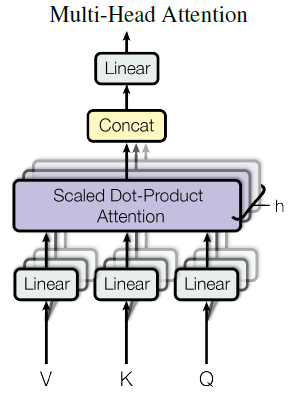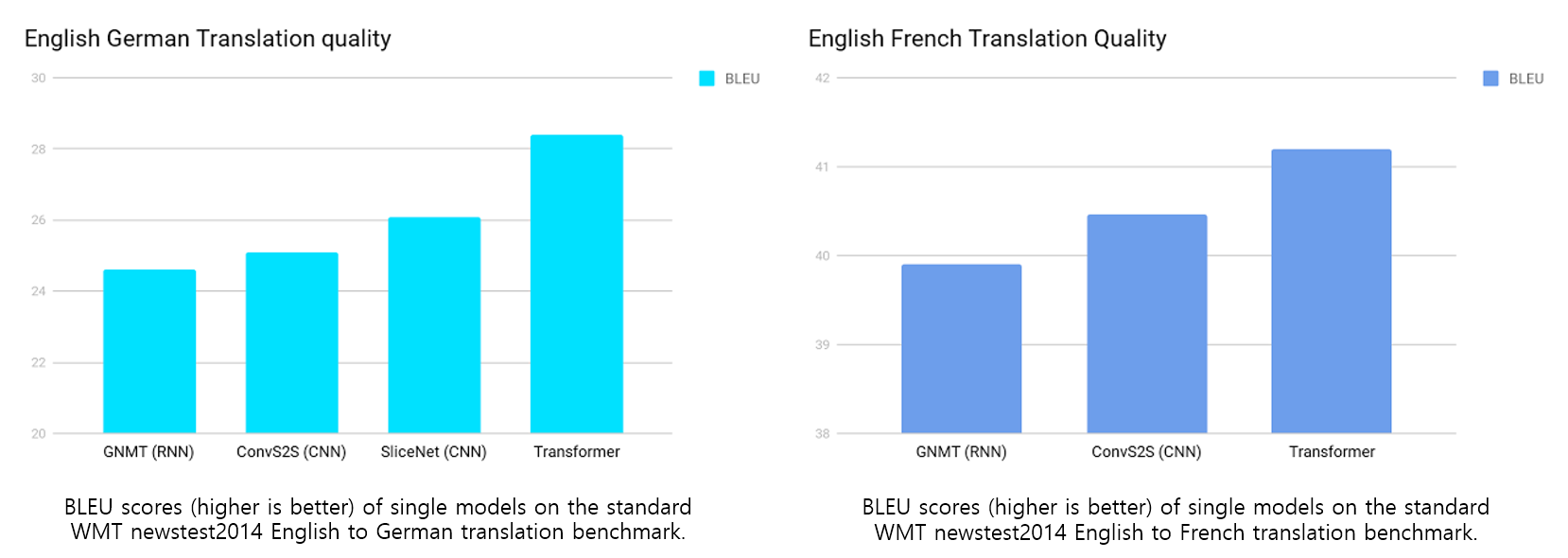The paper “Attention is all you need” from google propose a novel neural network architecture based on a self-attention mechanism that believe to be particularly well-suited for language understanding.
Introduction
Current Recurrent Neural Network
- Advantages
- Popular and successful for variable-length representations such as sequences (e.g. languages, time-series, etc)
- The gating models such as LSTM or GRU are for long-range error propagation.
- RNN are considered core of Seq2Seq with attention.
- Disadvantages
- The sequentiality prohibits parallelization within instances.
- Sequence-aligned states in RNN are wasteful.
- Hard to model hierarchical-alike domains such as languages.
- Long-range dependencies still tricky despite of gating models, so there are attempts to solve this by using CNN
Current Convolutional Neural Network
- Advantages
- Trivial to parallelize (per layer)
- Fit intuition that most dependencies are local
- The problem of long-range dependencies of RNN has been achieved by using convolution.
- Path length between positions can be logarithmic when using dilated convolutions, left-padding for text. (autoregressive CNNs WaveNet, ByteNet)
- The complexity of \(O(\log n)\) for ByteNet and \(O(n)\) for CovS2S
- Disadvantages
- Long-range dependencies using CNN are referencing things by position while referencing by context makes much more sense.
- WaveNet and ByteNet architecture for example below.

Attention
Attention between encoder and decoder is crucial in Neural Machine Translation (NMT). So, why not use (self-)attention for the representations?
Self-Attention

- Convolution sees only positional things while self-attention looks at everything considering similarity.
- Sometimes called intra-attention
- Relating different positions of a single sequence in order to compute a representation of the sequence.
- Pairwise comparison between every two positions on signal
- Comparison is used to generate distribution for each positions to other positions in weighted average.
Why Self-Attention?
- Total computational complexity \(O(1)\) by layer (v.s \(O(n)\) in RNN)
- Parallelizable computational capacity measured by minimum number of required sequential operations
- Constant path length between long distance dependencies in the network
- It is possible to generate a model in which self-attention can be more interpreted.
Three Ways of Attention

The Transformer
- Encoder-decoder structure of general neural sequence transduction models
- The encoder maps an input sequence of symbol representations \(x\) to a sequence of continuous representation \(z\).
- Given \(z\), the decoder then generates an output sequence \(y\) of symbols one element at a time.
- At each step the model is auto-regressive, consuming the previously generated symbols as additional input when generating the next.
Transformer follows this overall architecture using stacked self-attention and point-wise, fully connected layers for both the encoder and decoder.

- Encoder
- Composed of a stack of \(N=6\) identical layers, each has two sub-layers
- The first is a multi-head self-attention mechanism, and the second is position-wise fully connected feed-forward network.
- Employ residual connection around each of the two sub-layers, followed by layer normalization
- Decoder
- Composed of a stack of \(N=6\) identical layers, each has three sub-layers
- Two are the same with those of encoder, and a third sub-layer performs multi-head attention over the output of the encoder stack.
- Each sub-layer has residual connections, followed by layer normalization.
- Modify the self-attention sub-layer in the decoder stack to prevent positions from attending to subsequent positions.
- Example of how Transformer works

Scaled Dot-Product Attention
An attention function can be described as mapping a query and a set of key-value pairs to an output. The output is computed as a weighted sum of the values, where the weight assigned to each value is computed by a compatibility function of the query with the corresponding key.
The proposed scaled dot-product attention is described as below,
\[Attention(Q,K,V) = softmax(\frac{QK^T}{\sqrt{d_k}})V\]- \(Q\): query vector (current word what I am operating on)
- \(K\): key memory (find the most similar key)
- \(V\): value memory (get the value corresponding the similar key)
- \(d_k\): queries and keys of dimension
- \(d_v\): values of dimension

There are two most commonly used attention functions: additive attention and dot-product attention. The Transformer uses dot-product attention and scaling factor of \(\frac{1}{\sqrt{d_k}}\).
- Dot-product is quicker to calculate, it is more resistant to sparsity.
- It is easy to respond as in research.
- When \(d_k\) is large, it is assumed that the gradient becomes smaller as the dot product becomes larger, so scaling by \(\sqrt{d_k}\).
- Below table is time complexity comparison among attention, recurrent, and convolutional

- Almost every time, \(d\) (usually 1000) is larger than \(n\) (usually 20), so attention (\(O(n^2d)\)) is way faster than recurrent (\(O(nd^2)\)).
Multi-Head Attention
- What’s missing from Self-Attention?
- Convolution: a different linear transformation for each relative position. Allows you to distinguish what information came from where.
- Self-Attention: a weighted average
- The Fix: Multi-Head Attention
- Multiple attention layers (heads) in parallel (shown by different colors below figure)
- Each head uses different linear transformations.
- Different heads can learn different relationships.
Instead of performing a single attention function with \(d_{model}\)-dimensional keys, values and queries,
it is beneficial to linearly project the queries, keys and values \(h\) times with different, learned projections to \(d_k\), \(d_k\) and \(d_v\) dimensions, respectively.
On each of these projected versions of queries, keys and values we then perform the attention function in parallel, yielding \(d_v\)-dimensional output values.

Multi-head attention allows the model to jointly attend to information from different representation subspaces at different positions.
\[MultiHead(Q,K,V) = Concat(head_1, ..., head_h)W^O \\ \text{where } head_i = Attention(QW_i^Q, KW_i^K, VW_i^V), \\ W_i^Q\in \mathbb{R}^{d_{model}\times d_k}, W_i^K\in \mathbb{R}^{d_{model}\times d_k}, W_i^V\in \mathbb{R}^{d_{model}\times d_v}.\]Point-wise Feed-Forward Networks
- Feed-forward network which is applied to each position separately and identically.
- Consists of two linear transformations with ReLU activation in between.
Positional Encoding
- Transmit location information since there is no recurrent or convolutional layer.
- There are many choices of positional encodings, in this work, sine and cosine functions of different frequencies are used.
Experiments
- Data and Batch Processing
- WMT 2014 English - German Dataset and WMT 2014 English - French Language Data
- German: 4.5million sentence pairs and 37,000 tokens
- French: 36M sentences and split tokens into a 32,000 - sentence pairs are batched together with approximate sequence length
- Hardware and schedule
- One machine with 8 NVIDIA P100 GPUs
- Base model
- Approximately 0.4 seconds per each training step
- Total 100,000 step learning = 12 hours training
- Great model (big)
- Step time 1.0 seconds
- learning at 300,000 steps, 3.5 days
Machine Translation Results: WMT-14
On the WMT 2014 English-to-German translation task, the big transformer model (Transformer (big) in Table 2) outperforms the best previously reported models (including ensembles) by more than 2.0 BLEU, establishing a new state-of-the-art BLEU score of 28.4.
On the WMT 2014 English-to-French translation task, our big model achieves a BLEU score of 41.0, outperforming all of the previously published single models, at less than 1/4 the training cost of the previous state-of-the-art model.


Variations on the Transformer
To evaluate the importance of different components of the Transformer, the authors varied the base model in different ways, measuring the change in performance on English-to-German translation on the development set, newstest2013.




